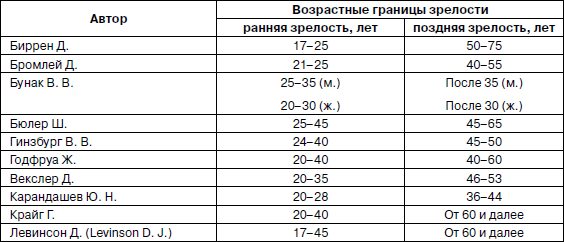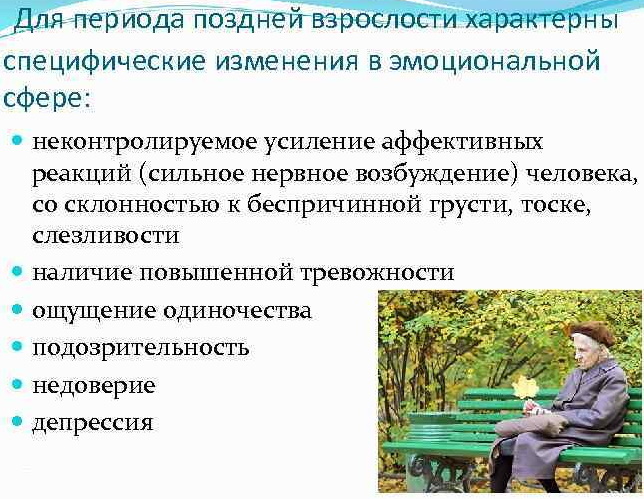Content
- Periodization of adulthood
- Age limits of maturity in the table
- How human behavior changes in different periods of adulthood
- Changes in mental functions
- Emotional changes
- Changes in the motivational sphere
- Change in the psychomotor sphere
- Changing personality traits
- Early adulthood (20 to 40 years old)
- Cognitive sphere
- Affective sphere
- Motivational sphere
- I-concept
- Behavior
- Middle adulthood (40 to 60 years old)
- Cognitive features
- Affective sphere
- Motivational sphere
- I-concept
- Behavioral features
- Late adulthood (60-70 years and older)
- Cognitive features
- Affective sphere
- Motivational sphere
- I-concept
- Behavioral features
- Videos about adulthood in psychology
The definition of maturity meets very often in various literature. In psychology, this means the longest period of life, during which a person reaches the highest development of the self-concept.
That is, he finds harmony, understands how to interact with the world around him, to be realized. In the process of growing up, everyone asserts himself in one area or another, arranges his life, takes care not only of himself, but also of his loved ones. Age crises, a weakening of psychophysical function, and a change in outlook become inevitable stages of growing up.
Periodization of adulthood
Experts consider different approaches to the periodization of adulthood. For example, if we turn to the most ancient of the mentioned concepts, it is worth highlighting the Chinese classification.
According to this periodization, there are 4 main periods of growing up:
| Growing up period | Age |
| Getting married | 20-30 years old |
| Performing basic public duties | 30-40 years old |
| Realization of their own mistakes and delusions | 40-50 years old |
| The final stage of creative implementation | 50-60 |

In the modern world, the frequency of maturity is considered a little differently.
For example, in 1966 D. B. Bromley also identified 4 stages of growing up:
- early (from 21 to 25 years old);
- middle (25-40 years old);
- late (40-45 years old);
- transition to old age (pre-retirement age - 55-65 years).
B. G. Ananyev considers growing up from 18 to 60 years old. Accordingly, according to his theory, early adulthood begins with the adulthood of a person. W. G. Craig pushes the limits even further and writes that the final stage lasts until death, that is, a person grows up throughout his life, from the age of 21 (according to Craig). The difference between different periods is due, first of all, to the fact that at different times the life expectancy of a person has changed, as well as the peculiarities of upbringing.
However, all authors agree that maturation is early, middle, and late. There is a discrepancy only in the age range.
If you put all the data together, then you can describe the 3 stages as follows:
- Early maturity. At this stage, a person is just entering adulthood. Also, this time is characterized by the peak of biological maturation. The person begins to plan a professional and personal future.
- Average maturity. The so-called heyday. At this stage, the peak of creative as well as professional achievements can be noted. With the onset of middle maturity, a person has more and more desire to share the accumulated knowledge. At the same time, he may suffer, remembering all his unrealized projects. This period accounts for the most divorces.
- Late maturity. It is characterized by the end of a professional career. At this stage, the person begins to prepare to become a pensioner. He experiences a phenomenon called the "empty nest" when he realizes that his children have already grown up. Also during this period comes the awareness of old age.
Age limits of maturity in the table
Adulthood is a common concept in psychology. But it is also one of the most controversial. It is most convenient to consider the age limits according to the authors, whose theories are the most popular and relevant.
| author | Early maturity, years | Late maturity, years |
| D. Birren | 14-25 | 50-75 |
| IN. IN. Bunak | 25-35 (women)
20-30 (men) |
35+ 30+ |
| NS. Buhler | 20-45 | 45-65 |
| IN. IN. Ginzburg | 24-40 | 45-50 |
| B. G. Ananiev | 18-25 | 47-60 |
| D. Wexler | 20-35 | 46-53 |
| J. Godefroy | 20-40 | 40-60 |
 Modern psychologists consider the stages of growing up in general terms:
Modern psychologists consider the stages of growing up in general terms:
- from 20 to 30 years old - early;
- from 30 to 40 years old - average;
- from 40 to 60 years old - late.
How human behavior changes in different periods of adulthood
With the advent of each new period of growing up, you can notice general changes in almost all people.
Changes in mental functions
First of all, there are changes in the sensory sphere:
- Decreased visual acuity. The maximum color sensitivity of human eyes is observed at the age of 20-30 years. After that, vision decreases.
- Hearing deteriorates. It is not so noticeable. Usually, people notice a serious deterioration in vision by the age of 50.
- Decreased attention. This begins to happen from the age of 34 (according to the theory of B. G. Ananyeva).
- Memory. According to research, short-term, auditory and other types of memory can be retained at the same level in the period from 18 to 30 years. After this, memory impairment is observed.
- Intelligence. D. Veksler argued that intelligence grows up to 20 years, and then remains at a stable level. From the age of 30, a person learns to use their mental abilities more productively. By the age of 60, the propensity for logical thinking begins to gradually decline. However, there are many other versions of how the development and decline of intellectual activity occurs. For example, there were studies according to which some of the subjects showed higher mental abilities at the age of 47-50.
- Creativity. According to A. TO. Kanatov, in men, creativity is able to remain at the same level in the period from 25 to 55 years. A marked decline in ability is observed after this age. In women, the drop in the level of creativity is not so noticeable and occurs gradually, that is, after 55 years, this function is quite active. But just like mental ability, creativity is very individual, so it is difficult to provide general statistics.
Emotional changes
Adulthood is a rather contradictory concept in psychology. Each specialist voices his theory of when the most noticeable changes in a person's behavior or perception occur.
For example, changes in the emotional sphere are very often referred to as the level of empathy. Most psychologists are inclined to believe that the level of compassion for others grows up to 40-50 years. At this age, empathy reaches its peak. This means that a 40-year-old has a significantly higher empathy than a 15-year-old.
After 50 years, women and men equally experience a decrease in empathy. In this case, the opposite is gradually happening. In contrast, a 60-year-old has a significantly lower level of compassion than adolescents. If we compare the intensity of empathy, then in women it is higher than in men at any age.
There is also a change in excessive emotional sensitivity (sentimentality). This indicator increases with age. For example, something that does not evoke any emotions in a person at the age of 15-20 can cause tenderness or a surge of emotions in a person who is 50-60 years old. Sentimentality in men and women develops in the same way.
Also, after 60 years, there is a gradual extinction of this function. It is noteworthy that men have more active jumps in sentimentality. However, due to a reluctance to express their emotions, males are less likely to show their true emotions than women.
Changes in the motivational sphere
A person's needs and interests change dramatically as they grow older. With age, a person can start doing completely opposite things, which he did not even think about before. According to studies, the older a person becomes (regardless of gender), the more important family and health status become for him. In turn, friends, passion, falling in love are gradually fading into the background.
The peak of motivation falls on 30 years. It is at this age that a person begins to seriously think about the future and make efforts in order to achieve what he wants. A beautiful life, appearance, second pleasures become less important. Stability comes. After 45-47 years, people devote more time to health, apply the received life wisdom.
Many experts are inclined to believe that as they grow older, the activity of the hormonal background also changes. That is, in the period after 18 years, people experience increased attraction, so it is more difficult for them to set more serious goals and focus on them. When the urge decreases, other aspirations appear.
Change in the psychomotor sphere
Adulthood in psychology is understood in many aspects. For example, it is also about developing muscle strength. In men, it increases until the age of 25, after which it decreases (we are talking about natural muscle strength, and not about going to the gym). By the age of 50, muscle mass may decrease by 10 kg or more. For women, the maximum falls on 21-23 years. After that, muscle strength also decreases, but not as drastically as in men.
Also, from 18-28 to 50-60 years, there is a preservation of the speed of motor reactions. Only by the age of 70 is there a noticeable decrease in the speed of movement of the arms and legs. Some experts think a little differently. They argue that motor functions remain at a high level up to 75, and until 80, they only slightly decrease.
Changing personality traits
As you grow older, there are a lot of changes in personal properties:
-
Responsibility. It is produced by the age of 25 and remains at about the same level throughout life.

- Aggressiveness. This is the so-called integral property, which can be expressed in different ways. In women, aggressiveness (it also includes assertiveness, vindictiveness, and other qualities) decreases as they grow older. By the age of 60-70, it decreases by almost 2 times. In men, the dynamics are slightly different. For example, by the age of 21 they have the highest level of vindictiveness, and then it decreases slightly. Also, among men, the highest level of intransigence falls on the age of 31-50. Then it decreases, but by 61 it rises again.
- Comfort. This figure is significantly higher in older people. This is due to the fact that by the age of 25-30 a person listens more to his opinion and concentrates less on what others think.
Early adulthood (20 to 40 years old)
Looking at early adulthood between the ages of 20 and 40, several changes can be identified.
Cognitive sphere
During this period, human mental functions develop unstably and are more heterochronous. Throughout the entire period of early adulthood, a person actively develops psychological and intellectual processes. Memory is actively developing. If short-term, verbal and other memory begins to fade over time, then figurative memory practically does not undergo changes.
At the age of 20-40, a person's thinking becomes complex. At the same time, different types of thinking can be integrated (theoretical, practical, figurative, visual-figurative). The development of speech is also actively continuing. Its qualitative parameters are changing. Mindfulness improves, in particular attention span. The person begins to accentuate him on certain things that arouse his greatest interest. From the age of 20, the control of intellectual development begins. A person develops more actively in different spheres (creative, professional).
Affective sphere
The main problem of 20-40 years is to achieve the necessary closeness, as well as identity. The point is that intimacy is the union of two identities. But without experience, a person is not able to remain himself at the same time, that is, not to lose the unique features peculiar to him. There is an awareness of the difference between love, passion, emotions.
During early adulthood, there are new emotions. For example, this includes parenting. For the first time, a person feels love for his child and begins to rethink how his parents treat him.
Motivational sphere
In the period of 20-40 years, impulsivity decreases. A person begins to assess circumstances more rationally, thanks to which we make balanced, not emotional decisions. There is an awareness of their actions. A person draws conclusions, gains experience.
With early adulthood, new life motivations appear. One of them is the creation of a family, the birth of a child. In addition to forming a family, career development begins. The person learns to reconcile his personal aspirations with the needs of the family. The latter can motivate him to develop more actively at work.
I-concept
It is characterized by self-actualization of the personality. The self-concept during this period is formed due to the experience gained. Its development continues further. In this case, a person is faced with internal and external stimuli.
Self-concept from 20 to 40 performs several functions at once:
- allows you to achieve internal coordination of the personality;
- interprets experiences and creates new expectations.
At this stage, difficulties arise, since women and men have different aspirations and needs. More precisely, the problem is created by the fact that people of the opposite sex do not yet fully understand and perceive each other's desires. For example, for the overwhelming majority of men, sexual satisfaction comes first.
They see their partner as a companion with whom they can have a good time, expect more responsibility from women, housekeeping. Women during this period are more in need of comfort, tenderness, stability and financial support. All these interests begin to coincide with partners much later. Therefore, the greatest number of divorces occurs at the age of 20-40.
Behavior
Behavioral features depend on a person's success, stability in professional activity, personal life. Behavior reflects whether a person has a family, whether he has achieved what he wants or is dissatisfied with his life.
Serious behavioral changes usually occur after the birth of children. Growing up is accelerating and the level of responsibility increases. This, in turn, encourages career development. Leisure activities differ depending on this. Those people who have children tend to focus more on their own needs. In turn, those who do not yet have children can devote more time to themselves.
Middle adulthood (40 to 60 years old)
In psychology, adulthood is a concept that is best considered privately. However, there are certain characteristics that are found in most people of the same age.
Cognitive features
During middle adulthood, a person is faced with psychological changes. He already has sufficient professional and life experience, has grown-up children, possibly grandchildren. Physiological changes take place. Accordingly, you have to adapt to many new things.
The main cognitive feature of middle adulthood is subjectivity when there is a real assessment of one's age. At the same time, the person notes that there are no major changes that he feared at the age of 20. Moreover, sensory functions are being developed more. A person feels and perceives what is happening better.
Affective sphere
The development of this area is uneven. For some people, this period becomes a kind of flourishing. They are realized creatively, travel. Others become obsessed with their age and the awareness of their mortality. It seems like time is running out very quickly, but there are no particular achievements.
A person places greater emphasis on work and development. Emotions begin to have a greater impact on mood, graying, can even affect professional activities. Also at this age, the risk of stress and the development of depression increases.
Motivational sphere
In middle age, there is a desire to act without unnecessary hesitation. A person wants to change his life for the better, which is a pretty strong motivation. There is a desire not only to be realized, but also to prepare the basis for the next generation, to pass on your experience.
This provokes a reassessment and comprehension of life. The person begins to adjust the value system and concentrates more on family and work. If a serious change occurs in any of these areas (for example, the loss of a job, a loved one, a forced move), then this can provoke a so-called motivational crisis.
I-concept
During the period of middle adulthood, the main events take place that form new tasks:
- achieve social responsibility and the required standard of living;
- form leisure activities;
- help the younger generation to realize responsibility;
- improve marital relations;
- adapt to physiological changes.
Behavioral features
Labor remains the main activity. By this age, a person achieves a good result, grows up the career ladder. Thanks to the accumulated experience, self-confidence grows. This allows you to compensate for the ongoing physiological changes.
In family life, relationships become more stable. Spouses complain less about each other, quarrel. Relations with children are improving, a feeling of harmony appears.
Late adulthood (60-70 years and older)
Adulthood is one of the most controversial concepts in psychology, although it may seem differently. In particular, this concerns the characteristics of the late period of growing up, which begins at the age of 60.
Cognitive features
The main feature of this period is age-related changes, that is, aging. The person notes hearing impairment and health problems. The body's activity is gradually weakened. People note a noticeable depression of physical strength, energy reserves. In most situations, problems arise with the immune and cardiovascular system. The skin loses its elasticity, a person wants to rest more.
Affective sphere
This period is characterized by specific changes in the emotional sphere. For example, people may notice a rather strong nervous excitement in themselves. Sometimes there is unreasonable sadness, you want to cry just like that.
Some older people are eccentric. This is due to the desire to stay young. At the same time, sensitivity decreases. A person is more immersed in himself, it is more difficult for him to cope with difficult life situations.
Motivational sphere
If after 60 years a person still has good health, then his needs differ little from those that were before. He wants to self-actualize, pass on experience and actively participate in the life of society. It is important for people of this age to be significant to others.
After 70 years, the main focus is on maintaining health. The need for participation in the lives of others gradually decreases. Interests focus on their own inner world. New hobbies appear (music, drawing, etc.).
I-concept
The self-concept during this period can be formed in a variety of ways. Usually people try to integrate their past into the present. If you can connect all the events, then life seems more successful. At this stage, a person must learn to resolve normative crises as well as conflicts. During this period, it is important to adapt to new conditions and learn to accept the experience of past years.
Behavioral features
Older people are more cautious. They constantly begin to think that danger awaits them everywhere. They fearfully walk down the street in the evening, shudder when the phone rings. Due to this, social activity is significantly reduced. Some older people begin to lead a reclusive lifestyle. Professional activity is no longer important. Many during this period begin to have a greater interest in religion.
Considering adulthood in psychology, you need to understand that this concept has many variations. Experts still cannot agree on the periods of growing up. There are also a lot of nuances that characterize this or that stage of growing up.
Videos about adulthood in psychology
Emotional adulthood:



